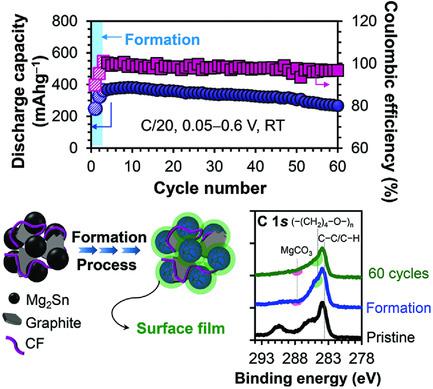当前位置:
X-MOL 学术
›
Adv. Mater. Interfaces
›
论文详情
Our official English website, www.x-mol.net, welcomes your
feedback! (Note: you will need to create a separate account there.)
Unveiling the Roles of Formation Process in Improving Cycling Performance of Magnesium Stannide Composite Anode for Magnesium‐Ion Batteries
Advanced Materials Interfaces ( IF 4.3 ) Pub Date : 2018-10-08 , DOI: 10.1002/admi.201801039 Giang Thi Huong Nguyen 1 , Dan‐Thien Nguyen 1 , Seung‐Wan Song 1
Advanced Materials Interfaces ( IF 4.3 ) Pub Date : 2018-10-08 , DOI: 10.1002/admi.201801039 Giang Thi Huong Nguyen 1 , Dan‐Thien Nguyen 1 , Seung‐Wan Song 1
Affiliation

|
The combination of Mg2+‐insertion type anodes with various Mg‐free cathode counterparts and electrolytes enables Mg‐ion batteries. Microsized magnesium stannide (Mg2Sn) active material for a potential Mg2+‐insertion anode has shown extremely low capacity and low Coulombic efficiency in the early cycles, due to not yet a full participation of active material and an irreversible capacity loss by anode–electrolyte interfacial reactions. An activation process, i.e., formation cycle, is necessary to mitigate those issues and to improve the cycling performance. Herein, the application of formation process to the Mg2Sn composite anode that includes graphite as an electrochemically inactive but electronically conductive component, the condition optimization of formation process, and the systematic studies of the effects of formation process on the cycling performance and anode–electrolyte interfacial reactions are reported. A basic understanding of the early cycling behavior and interfacial phenomena of Mg2Sn anode is provided, which gives insight into improvement of performance of alloy anodes in Mg‐ion batteries.
中文翻译:

揭示了形成过程在改善镁离子电池用锡化锡复合阳极的循环性能中的作用
Mg 2+插入型阳极与各种无Mg阴极对应物和电解质的结合使Mg-ion电池成为可能。潜在的Mg 2+插入阳极的超细锡化镁(Mg 2 Sn)活性材料在早期循环中显示出极低的容量和低库仑效率,这是由于活性材料尚未充分参与以及阳极不可逆转的容量损失–电解质界面反应。为了减轻这些问题并改善循环性能,激活过程(即形成周期)是必不可少的。此处,形成工艺在Mg 2中的应用报道了以石墨为电化学非活性但导电成分的锡复合阳极,优化了形成过程的条件,并系统研究了形成过程对循环性能和阳极-电解质界面反应的影响。提供了对Mg 2 Sn阳极的早期循环行为和界面现象的基本了解,从而深入了解了Mg离子电池中合金阳极的性能。
更新日期:2018-10-08
中文翻译:

揭示了形成过程在改善镁离子电池用锡化锡复合阳极的循环性能中的作用
Mg 2+插入型阳极与各种无Mg阴极对应物和电解质的结合使Mg-ion电池成为可能。潜在的Mg 2+插入阳极的超细锡化镁(Mg 2 Sn)活性材料在早期循环中显示出极低的容量和低库仑效率,这是由于活性材料尚未充分参与以及阳极不可逆转的容量损失–电解质界面反应。为了减轻这些问题并改善循环性能,激活过程(即形成周期)是必不可少的。此处,形成工艺在Mg 2中的应用报道了以石墨为电化学非活性但导电成分的锡复合阳极,优化了形成过程的条件,并系统研究了形成过程对循环性能和阳极-电解质界面反应的影响。提供了对Mg 2 Sn阳极的早期循环行为和界面现象的基本了解,从而深入了解了Mg离子电池中合金阳极的性能。









































 京公网安备 11010802027423号
京公网安备 11010802027423号